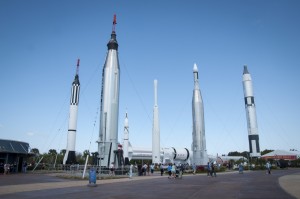Space Center Relives My Rocket-Obsessed Youth
 CAPE CANAVERAL, FLA. — My fascination with astronauts and the space program was launched when Mercury astronaut Alan Shepherd rode on the back of a red convertible in a parade through downtown Pembroke, N.H. in 1961. He had just become the second person and the first American to reach outer space, as it was quaintly called then. The United States and the Soviet Union were on a race to the moon. I was hooked on all things to do with rockets, launches and splashdowns, and especially the brave men who were strapped in to tiny capsules and sent soaring into the heavens. (Women wouldn’t get their chance until Sally Ride flew into space in 1983, when I was already an adult.)
CAPE CANAVERAL, FLA. — My fascination with astronauts and the space program was launched when Mercury astronaut Alan Shepherd rode on the back of a red convertible in a parade through downtown Pembroke, N.H. in 1961. He had just become the second person and the first American to reach outer space, as it was quaintly called then. The United States and the Soviet Union were on a race to the moon. I was hooked on all things to do with rockets, launches and splashdowns, and especially the brave men who were strapped in to tiny capsules and sent soaring into the heavens. (Women wouldn’t get their chance until Sally Ride flew into space in 1983, when I was already an adult.)
Uncle Al, my mother’s brother-in-law and a career Navy man, served aboard one of the iterations of the USS Wasp. It recovered Gemini IV, V and VI in the mid-1960s. He sent along Gemini souvenir patches and some autographed photos of astronauts, which further cemented my enthusiasm for all things NASA. In 1969, as a paperboy I sold extras of the Longview Daily News when Apollo 11 landed on the moon. Many years later, I helped direct news coverage for the Nacogdoches and Lufkin papers when the space shuttle Columbia exploded in the skies above East Texas — a sad, horrifying time.
I still believe in the value of exploring space, despite its tremendous cost and risk. NASA is now retooling, and there are no manned flights. Likely the next flights to launch from America will come from the private sector. American astronauts headed to the space station now hitch rides on Russian spacecraft. That saddens me. I feel we have lost something, a sense of pioneering spirit and adventure.
While in Florida for my daughter Kasey’s wedding, I could not resist a short trip over to the Kennedy Space Center. At $50 the admission ticket is pricey; I guess NASA is trying finance the next manned mission on the backs of tourists. For me, it was worth it to see first-hand the spacecraft that captivated my youth, The Mercury capsule held Shepherd, in a roughly 11-foot by 6-foot pod with just 100 cubic feet of habitable space. It was launched by a Mercury-Atlas rocket, one of seven rockets on display in front of the main visitors’ center at Kennedy, gleaming on this spring morning in the Florida sunshine.
NASA calls it the Rocket Garden, this lineup of rockets pointed toward the heavens: Juno I, Mercury-Redstone, Thor, Gemini-Titan II and Saturn IB. My son-in-law Matt and I walk around mouths agape. Already our money feels well spent. He is an engineer and equally fascinated by the space program and its legacy. I try to imagine what it was like to be alone, strapped inside the Mercury capsule on top of the Atlas rocket more than 50 years ago, wondering if one would return alive. At least that is what I would be wondering.
We explored every exhibit hall, most filled with interactive displays designed to keep the younger set amused with tactile screens and lots of fun buttons to push. We were more interested in the cool memorabilia, like actual spacesuits that had been in orbit, the Apollo 13 lunar excursion module on display — the real things, in other words. So we were skeptical when entering the final hall, where we were finally stuck in a tour, which we had successfully avoided until then. We both avoid structured tours, but this hall, the last leg of the space center, gave us no choice.
Matt and I sat through an interesting Imax-like film about the beginning of the shuttle program. A huge door opened vertically, and our crowd was ushered into another large auditorium for the second phase of the shuttle history. It was again interesting, but I was getting impatient.
Then the final vertical door opened and before us was the actual Space Shuttle Atlantis, with its payload doors wide open and robotic arms fully extended. Until one sees a shuttle up close like this, it is impossible to appreciate the magnitude of the program — building a reusable spacecraft capable of taking 3 million pounds of cargo into space. Walking around the last shuttle to orbit the earth was as inspiring as seeing Alan Shepherd in that parade nearly 60 years ago.
Nice finale, NASA! Now let’s get back to work, putting American astronauts back in space on American spacecraft, OK?
Leave a reply
Fields marked with * are required











